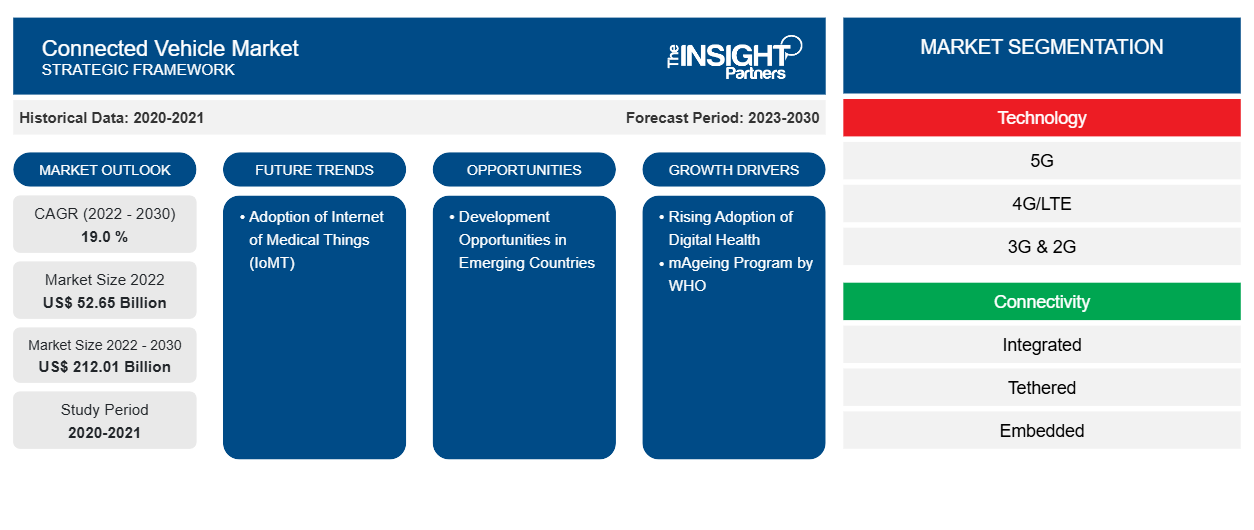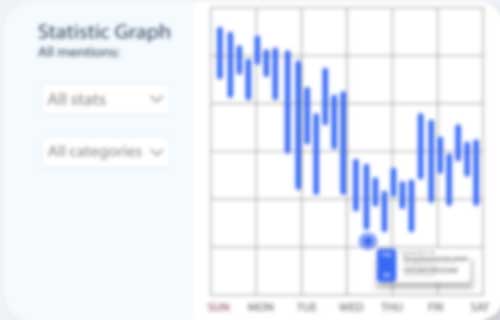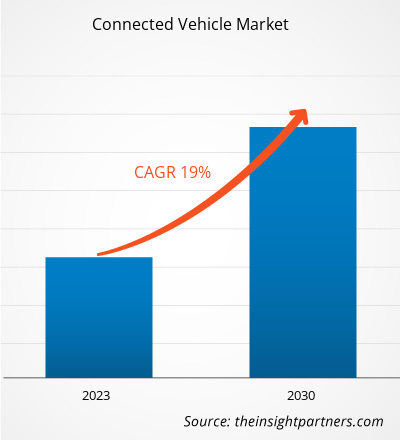[Research Report] The connected vehicle market accounted for US$ 52,649.57 million in the year 2022 and is expected to grow at a CAGR of 19.0% during the period 2022 - 2030, to account for US$ 2,12,012.9 million in the year 2030.
Analyst Perspective:
The global connected vehicle market is segmented into North America, Europe, Asia Pacific, Middle East & Africa, and South America. Connected vehicles are devices, software, or systems that use V2X communications to improve road safety, system efficiency, or mobility. It uses data collected through short-range communication and peer-to-peer and vehicle-to-vehicle communication to analyze what other vehicles, bikers, pedestrians, and others are doing and detect potential risks.
Technological advancements and a growing focus on safety and convenience are among the major driving factors of the connected vehicle market in North America. The US is leading in the North American connected vehicle market. The growing concern about mitigating greenhouse gas emissions and controlling the carbon footprint influences the Europe connected vehicle market positively. The increasing advancement in the telecom infrastructure and growing technological development in the automotive sector also drive the connected vehicle market in Europe. Germany, France, and the UK are among the significant contributors to the Europe connected vehicle market.
Increasing smart city initiatives, investment in developing infrastructure, and rising disposable income are major driving factors for the Asia Pacific connected vehicle market. China, Japan, South Korea, and India are major countries in the Asia Pacific connected vehicle market.
Market Overview:
The automobile industry has undergone a fundamental transition affecting the connected car market positively in recent years. Vehicles in this dynamic industry are distinguished by their advanced sensor, communication, and software capabilities, which allow them to connect to the internet, other vehicles, infrastructure, and numerous digital platforms. Numerous opportunities and applications have been made possible by these connected automobiles, ranging from improved safety features and real-time traffic updates to autonomous driving capabilities and customized in-car experiences.
One of the driving forces behind the growth of the connected vehicle market is the increasing consumer demand for connectivity and convenience. Consumers are now expecting seamless integration of their smartphones to access navigation and entertainment apps and to monitor and control their vehicles remotely. Moreover, businesses and industries are exploring the potential of connected fleets for improved logistics, fuel efficiency, and vehicle management. On the other hand, connected vehicles are raising concerns about data privacy and cybersecurity risks; as a result, the market is facing regulatory and cybersecurity issues. Governments and businesses are establishing norms and rules to guarantee the deployment of connected vehicles securely and safely.
Customize This Report To Suit Your Requirement
You will get customization on any report - free of charge - including parts of this report, or country-level analysis, Excel Data pack, as well as avail great offers and discounts for start-ups & universities
Connected Vehicle Market: Strategic Insights

- Get Top Key Market Trends of this report.This FREE sample will include data analysis, ranging from market trends to estimates and forecasts.
Customize This Report To Suit Your Requirement
You will get customization on any report - free of charge - including parts of this report, or country-level analysis, Excel Data pack, as well as avail great offers and discounts for start-ups & universities
Connected Vehicle Market: Strategic Insights

- Get Top Key Market Trends of this report.This FREE sample will include data analysis, ranging from market trends to estimates and forecasts.
Market Driver:
Growing demand for driving assistance system
The advancement of Advanced Driver Assistance Systems (ADAS) has positively impacted the connected vehicle market, reshaping the automotive landscape in several significant ways. ADAS is a powerful catalyst for the increased adoption of connected vehicle technology. These systems include features such as adaptive cruise control, blind-spot monitoring, and automated parking assistance, which have garnered immense attention for their potential to enhance road safety. As a result, consumers are valuing and actively seeking vehicles equipped with ADAS. This surge in demand is driving automakers to integrate more sophisticated connectivity features into their cars. For instance, as per the study done by the American Automobile Association, ~40% of US consumers expect at least one driver support system. As a result of such demand, the country has more than 60 million vehicles equipped with the ADAS system.
Automakers are also investing significantly in building robust, high-speed communication networks within vehicles, a critical component for the seamless operation of ADAS. This investment in connectivity infrastructure is simultaneously driving advancements in the broader connected vehicle market. For instance, in 2018, BMW invested capital in Blackmore Sensors and Analytics, Inc., which manufactures frequency-modulated continuous wave (FMCW) lidar for the automotive industry. Blackmore used the investment to scale the production of its FMCW lidar sensor for advanced driver assistance systems (ADAS) and self-driving markets. In addition, in 2021, Volkswagen Group partnered with Microsoft to fast-track the development of automated driving.
Segmental Analysis:
Based on Network Type, the connected vehicle is divided into 5G, 4G/LTE, and 3G & 2G. Continuous development activities, along with the increasing need for faster and more efficient internet connections, are the factor that is supporting the 4G and 5G growth.
The fifth generation of communication networks offers considerable improvements over its forerunners. Higher speeds, lower latency, more capacity, and enhanced dependability have been added, creating new business opportunities. The foundation for connected and autonomous automobile networks is mainly laid by 5G. This technology connects vehicles, infrastructure, network services, bicycles, and pedestrians. The growing popularity of software-defined vehicles is one of the main factors facilitating this shift. Software is used to implement a growing portion of a vehicle's functionality, which may be updated or modified over time. This change enables automobile OEMs to supplement their existing revenue models with subscription-based or on-demand service models. The capacity to increase safety throughout the vehicle's life cycle more effectively than before is another benefit of the 5G-connected automobile. With linked car technology becoming increasingly popular, some automakers are utilizing data collection and analysis to open up new possibilities for vehicle upkeep, aftermarket sales, and services.
- This FREE sample will include data analysis, ranging from market trends to estimates and forecasts.
Regional Analysis:
The North American connected vehicle market is segmented into the US, Canada, and Mexico. The connected vehicle industry has garnered high revenue in North America due to a convergence of market-specific factors that create a favorable environment for growth and investment. Firstly, North America boasts a mature and technologically advanced automotive sector. Leading automotive manufacturers, technology companies, and service providers have recognized the immense potential of the market in North America and have accordingly invested in R&D and deployment of connected vehicle technologies. In addition, the regulatory landscape in North America has been influential in driving the demand for connected vehicle market’s growth. Regulatory bodies have taken a proactive stance toward encouraging the incorporation of connectivity features in vehicles, recognizing the potential for improved safety and efficiency. These regulatory initiatives have incentivized automakers to integrate connected technologies into their vehicle offerings.
The consumer base in North America is marked by a strong preference for technology and innovation. Consumers in the region have shown a high demand for vehicles equipped with advanced connectivity features, such as in-car Wi-Fi, seamless smartphone integration, and sophisticated infotainment systems. This consumer-driven demand has translated into higher sales and revenue figures for connected vehicles in the market.


- This FREE sample will include data analysis, ranging from market trends to estimates and forecasts.
Key Player Analysis:
Harman International, Visteon Corporation, Vodafone Group, Audi AG, Robert Bosch, General Motors, Continental AG, AT&T, Denso Corporation, and BMW Group are among the key players operating in the connected vehicle market.
Recent Developments:
Inorganic and organic strategies such as mergers and acquisitions are highly adopted by companies in the global connected vehicle market. A few recent developments by key the connected vehicle market players are listed below:
Connected Vehicle Report Scope
| Report Attribute | Details |
|---|---|
| Market size in 2022 | US$ 52.65 Billion |
| Market Size by 2030 | US$ 212.01 Billion |
| Global CAGR (2022 - 2030) | 19.0 % |
| Historical Data | 2020-2021 |
| Forecast period | 2023-2030 |
| Segments Covered |
By Technology
|
| Regions and Countries Covered | North America
|
| Market leaders and key company profiles |
- Historical Analysis (2 Years), Base Year, Forecast (7 Years) with CAGR
- PEST and SWOT Analysis
- Market Size Value / Volume - Global, Regional, Country
- Industry and Competitive Landscape
- Excel Dataset


- Water Pipeline Leak Detection System Market
- Social Employee Recognition System Market
- Fixed-Base Operator Market
- Mesotherapy Market
- Dropshipping Market
- Truck Refrigeration Market
- Single-Use Negative Pressure Wound Therapy Devices Market
- Virtual Production Market
- Architecture Software Market
- Organoids Market

Report Coverage
Revenue forecast, Company Analysis, Industry landscape, Growth factors, and Trends

Segment Covered
Technology, Connectivity, Application, and Geography

Regional Scope
North America, Europe, Asia Pacific, Middle East & Africa, South & Central America

Country Scope
This text is related
to country scope.
Frequently Asked Questions
The advancement of Advanced Driver Assistance Systems (ADAS) has positively impacted the connected vehicle market, reshaping the automotive landscape in several significant ways. ADAS is a powerful catalyst for the increased adoption of connected vehicle technology.
Europe's automotive industry has long been a cornerstone of the global automotive landscape, known for its tradition of engineering excellence, innovation, and quality. The industry is accounting for ~20% of global production. The adoption of connected vehicles is gaining momentum across the continent.
The data monetization trend in the connected vehicle industry is exploring innovative ways to leverage the vast amounts of data generated by connected vehicles for financial gain while also delivering value to vehicle owners and third-party stakeholders. One prominent trend is the usage-based insurance (UBI).
Harman International, Visteon Corporation, Robert Bosch, and General Motors are the key market players operating in the global connected vehicle market.
The increasing focus on smart city initiatives drives investments in infrastructure ultimately supporting the growth of the connected vehicles market. In addition, the rising adoption of fully autonomous vehicles is expected to significantly impact the demand for the connected vehicle market in the coming years, reshaping the automotive industry.
Trends and growth analysis reports related to Automotive and Transportation : READ MORE..
The List of Companies - Connected Vehicle Market
- Harman International
- Visteon Corporation
- Vodafone Group
- Audi AG
- Robert Bosch
- General Motors
- Continental AG
- AT&T
- Denso Corporation
- BMW Group

 Get Free Sample For
Get Free Sample For